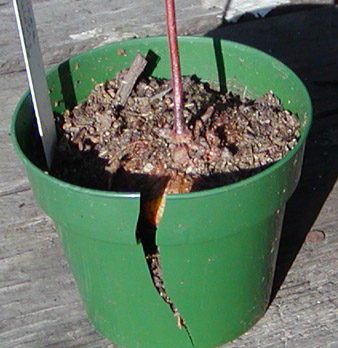
| Species list |
Hybrids list |
Tubers list |
Topics list |
Site index |
What's new |
Home page |
Please give me some good advice in your next letter. I promise not to follow it.
-- Edna St. Vincent Millay, 1952
Boy, are you in the wrong place!
But if you insist on some words about how I grow sinningias and their kin, here they are.
I grow almost all my sinningias, vanhoutteas, and paliavanas the same. Unless stated otherwise, they're all outdoors, all top-watered, all in relatively large pots (roughly double the size of the tuber, if the plant has one), and all planted in the same mix.
This mix is called "Supersoil" -- it comes in two-cubic-foot bags which
I buy at my local garden store.
Most people use it for growing container plants like petunias, carrots,
zinnias, and tomatoes.
It contains "forest products", which I fervently hope does not mean
That being said, it should be admitted that not everything flourishes in this mix. Among the supersoil-haters are African violets, chiritas, and anything needing terrarium conditions.
For them (if I insist on growing them), I buy packaged African violet mix.
So. The exceptions.
I grow Sinningia muscicola ("Rio das Pedras") indoors, under lights or in a window. But it's in supersoil, just like the other sinningias, and doesn't seem to mind.
I inherited S. pusilla and S. concinna from a friend, the late Fred Stryker, so they're in a peat mix that he used.
Paliavana plumerioides doesn't like my outdoor temperatures. So my last one is under lights, where it will never bloom, and will eventually find a reason to expire. It does, however, survive in supersoil.
I grew the following from seed, got them to flower, and then could not keep them alive. In most cases, the tuber eventually did not come back in the spring. So you might want to try somebody else's advice for these species.
I grew the following from seed but could not keep them alive. I received S. macrophylla from Karyn Cichocki and it is growing in her mix. I received a tuber of S. rupicola from Tsuh Yang Chen and restarted S. nivalis from seed; they're both growing now in Supersoil, so I have my fingers crossed.
Some plants bloom fine for other people but not for me. I get large plants but no flowers. I don't get it. Obviously.
Has never bloomed:
Bloom, but not easily or abundantly:
I tried growing the following from seed, got germination, but could not keep the seedlings alive. Never got anywhere close to a flower. So you really want to listen to somebody else here.
Inherited wisdom about where to place the tuber in the pot comes down to just a few items:
I follow these rules, but only half-heartedly. Rule #2 seems useful to provide extra support for the stem.
Jon Dixon claims that the exposed portions of tubers will suffer damage more readily during freezes. This seems logical. I can't offer any evidence one way or the other, because I usually don't leave my tubers in soil over the winter. I dig them up, put them in brown paper lunch sacks together with their labels, and put all the sacks in several large containers, which I leave outdoors, in a place sheltered from the rain.
That being said, it must be added that sometimes I don't get around to unpotting all the tubers, and some of them are forced to sit in the pot all winter, out in the rain, exposed to temperatures near freezing. Inherited wisdom: cold + wet = rotten mushy tubers = dead.
My mother and father had wisdom enough for eighty-seven people,
but somehow I didn't manage to inherit much.
So some of my sinningia tubers have sat out in the rain for months,
with night-time temperatures hovering around 35F plus or minus
5 degrees (-1C to 4C).
I have some experience in that regard, therefore, and my
conclusion is that
Tubers must have mechanisms to protect themselves against
I was not completely oblivious to my parents' wisdom, however, and what I did inherit was more precious than rubies: spend less than you receive, give away what you can. Not directly applicable to the genus Sinningia, but still...
A few years ago, my wife and I went to see "An Ideal Husband", by Oscar Wilde. In it, a character says, "I always pass on good advice. It is the only thing to do with it. It is never any use to oneself."
You knew I was going to say this, but here it is anyway.
Don't pay any attention to me, or anybody else.
Try a variety of things in your own growing conditions and with your
own growing materials, and go with what works best.
When it comes to horticulture, be a writer, not a reader!
| Sometimes tubers give horticultural advice. Here one is saying it's time for repotting. |

|